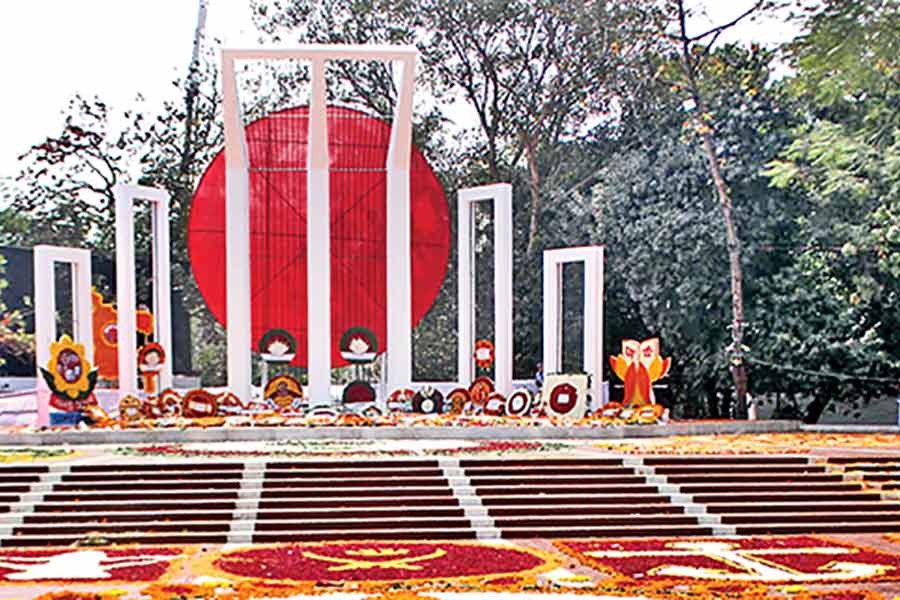
Published :
Updated :

The similarity is uncanny. It could be seen clearly in the process of the dilapidation creeping into EkusheyShaheedMinars built in the then-province of East Pakistan, and the short shrift given to Liberation War monuments. The former were built to pay tributes to the 21st February Language Movement martyrs demanding Bangla be declared the state language of Pakistan. Those were built in the nineteen fifties onwards.The latter began springing up across the independent Bangladesh to pay tributes to the Liberation War martyrs. They began being built across Bangladesh in a bout of spontaneity rarely seen in the world. Both the commemorative monuments carried the feelings of mourning and pathos as well as of protest and resolve.
In the cases of the Language Martyr monuments, the first one, aptly called ShaheedMinar, was built near the present Dhaka Medical College Hospital on 23rd February in 1952. The atmosphere was fraught and tense. The whole Dhaka had been in the grip of a pervasive fear. The blood that gushed forth from the bullet wounds of the dying students the previous day had been there dried and clotted. The impromptu monument was razed to the ground by the police the next day. Today's renovated Central ShaheedMinar was built much later. In the cases of the 1971 Liberation War monuments, they also began to be built across Bangladesh. Watching the two events in parallel, both carry almost similar importance. Viewing them historically, both the events carry equal importance to the nation. The Liberation War, however, played the greatest role in the country's independence as the world's only Bangla-dominant nation. While building these memorial installations, it's the consummately warm and patriotic feelings which remained at work all along. These feelings intensified in the 1960s, with the popular uprising in the then East Pakistan taking the form of a mass movement. To the woes of the Language Movement participants, it didn't take long for the ShaheedMinars to start becoming prematurely derelict.
Those were originally built in an improvised manner. The neglect of the institutions related to their construction added to their fast collapse. Upon standing unattended and uncared for year in and year out, except on the Shaheed Day morning, those monuments began wearing out. A lot of them have vanished into the abyss of time, with hardly any trace. Although there are hundreds of Ekushey monuments still standing in many parts of Bangladesh, their derelict condition warrants just pity --- as well as a feelingof distress.
The way they are reaching their near-extinction may have been far from the farthest corners of people's mind. Their plight triggers only sadness. Lots of people fear that except the Central ShaheedMinar in Dhaka and those erected at different times at the other universities, colleges and the famous schools, these monuments may become a rare spectacle in the whole country. Neglect shownto them is just a single feature related to these monuments. Only a couple of decades ago, campaigns of desecrating the monuments, related to both the Language Movement and the Liberation War were reported from different parts of the country. Fingers were pointed at the unscrupulous sections in society. To the woes of the sensible segments of people, these incidents point towards the extent to which the signs of social rot have lately surfaced.
The erection of the first monument dedicated to the spirit of the 1971 Bangladesh Liberation War was inaugurated on the Dhaka University campus in 1979. With work beginning in 1973, the landmark sculpture took six years to get completed. The sculpture called 'Oprajeyo Bangla' was built by sculptor Abdullah Khalid. The inaugural ceremony was held on the Victory Day on 16 December in 1979. 'Oporajeyo Bangla' was the maiden sculpture commemorating the Bangladesh Liberation War in the country. However, the National Martyrs' Memorial, the official monument dedicated to the 3 million martyrs killed in the 9-month Liberation War was declared the official memorial dedicated to the liberation in 1971. Located at Savar, 35km from Dhaka, it was opened to public in 1982. Architect Syed Mainul Hossain planned the grand structure, located on a vast open space. In Bangla, it is called JatiyaSmritiSoudha.
In a short period, dozens of memorials sprang up across the country. Celebrated and noted sculptors had conceived of their designs. Brilliant young talents were also found engaged in designing and erecting the monuments. The monuments and sculptures included Bashtala Memorial in Sylhet, Shiromoni Memorial in Khulna, Martyrs' Memorial Pillar in Mymensingh. Senior artist and sculptor NitunKundu's 'Sabash Bangladesh' is now considered a major memorial dedicated to the Liberation War martyrs. Showing two Liberation Fighters on ambush, it was built on the campus of Rajshahi University in 1991.
Coming to the Liberation War martyrs' monuments, the general people have all along been demonstrating unalloyed respect for the monuments. To them, these memorials stand for their national identity, as well as their dignified position in the global perspective. These people have never heard of the dark alleyways of politics. What have given their existence a meaning are their national identity and their cultural ethos. All this has its roots in the 1952 Language Movement, and the 1971 War of Liberation.
The younger generations may not be able to feel the importance of the role of these movements in the emergence of an independent Bangladesh. To the older generations, the countdown to the face-off with the neo-colonial enemy forces served as a platform for the Liberation War. They cannot allow the great patriotic war's spirit go awry.


 For all latest news, follow The Financial Express Google News channel.
For all latest news, follow The Financial Express Google News channel.